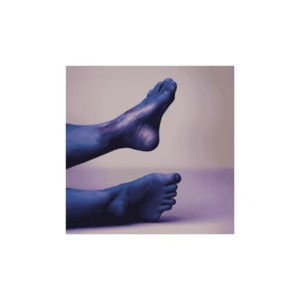Introduction:
A bruising around ankle is a soreness or tenderness of skin and tissues with localized discoloration. Any stress or trauma to blood vessels near the surface of the skin around the ankle is responsible for bruise. Sometimes blood vessels are injured inside your skin, leading to leaking of blood into the surrounding tissues. As a result a purple, blue, or blackish bruise appears. In the case of bruising around ankle, the injury likely occurred in the area around the ankle joint.
But before going ahead, let’s define what’s bruising?
Bruise is a common skin injury that occurs when blood vessels are damaged beneath the skin. The blood leaks into the surrounding tissues and accumulates near the surface of the skin. The skin appears blue, purple, or black which is a sign of bruise.
The Ankle Anatomy:
The ankle is a complex joint that has a pivotal role in supporting the body’s weight and helps in movement. Several factors contribute to the ankle’s susceptibility to unexplained bruising:
Vascular Anatomy:
The ankle has a network of blood vessels supplying the tissues. Any trauma or injury can lead to blood vessel damage, causing bruising. The proximity of the skin to the bones and ligaments increases the visibility of bruising.
- Thin Skin:
The skin around the ankle is relatively thin and is more prone to bruising.
- Subcutaneous Tissue:
There is limited subcutaneous tissue (fat) around the ankle. This lack of fat around the ankle makes the blood vessels more vulnerable to damage.
- Joint Complexity:
The ankle joint is formed by the talus bone of the foot and the fibula and tibia bones of the lower leg. Its complex structure involves ligaments and tendons.
Causes of unexplained bruising around ankle
Bruising can be a cause for concern and may be indicative of various medical issues. I can provide you with some general information on potential causes of unexplained bruising:
-
Trauma or Injury:
Sometimes, people may not remember a minor injury or bump that could have caused the bruise. It is not uncommon for bruises to appear a day or two after the initial injury.
-
Medications:
Some drugs like blood thinners, may increase the development of bruising.
-
Bleeding Disorders:
Some clotting disorders like hemophilia, can lead to easy bruising.
-
Vitamin Deficiencies:
Vitamin C and vitamin K deficiency, can contribute to bruising.
-
Aging:
As you get older, the skin becomes more fragile, and your blood vessels may become more prone to breaking which may result in bruising.
-
Liver Disease:
Blood clotting factors are affected by some liver disorders and thus lead to bruising.
-
Autoimmune Diseases:
Rheumatoid arthritis or lupus erythematosus may cause inflammation and affect blood clotting, potentially leading to bruising.
-
Certain Cancers:
In some cases, unexplained bruising can be associated with certain types of cancers. However, this is relatively rare.
-
Sprain or Strain:
Ankle sprains or strains can lead to bruising. The injury might have occurred during physical activity that is forgotten.
-
Varicose Veins:
Varicose veins can cause blood pooling in the veins, leading to discoloration or bruising around the ankle.
-
Venous Insufficiency:
This condition occurs when the veins have trouble returning blood from the legs to the heart, which is causing pooling and potential bruising.
If you notice persistent or worsening bruising without an obvious cause, we recommend you to seek medical advice.
-
Muscle Strain or Sprain:
Injuries to the muscles or ligaments in the ankle may cause pain without necessarily resulting in visible bruising. Sprains may appear due to overuse, sudden twisting, or trauma.
-
Tendonitis:
It is the Inflammation of the tendons around the ankle. This condition may not always be accompanied by bruising.
-
Stress Fractures:
Tiny cracks in the bones, known as stress fractures, can cause pain without immediate bruising.
-
Nerve Compression:
Nerve compression or tarsal tunnel syndrome can lead to pain in the ankle without visible bruising. Nerves can be compressed or injured due to various factors
-
Bursitis:
Inflammation of the bursae is called bursitis, small fluid-filled sacs that cushion joints, and can lead to pain around the ankle. Bursitis may not always result in bruising.
-
Gout:
Gout is formed by accumulation of uric acid crystals in the joints leading to severe and sudden pain in the ankle joint without obvious bruising.
-
Peripheral Neuropathy:
Conditions affecting the nerves, such as peripheral neuropathy, are responsible for pain, numbness or tingling in the ankles without external signs of trauma.
-
Referred Pain:
Pain in the ankle may originate from another area. Identifying the source of the pain may not always involve visible bruising on ankle.
Bruising around ankle without injury in Seniors/elders
Ankle bruising in seniors can be a common occurrence due to various factors related to aging. Here are some considerations for ankle bruising in seniors:
- Skin Changes:
With the advancement in age, the skin becomes thinner and loses some of its elasticity. This makes older adults more vulnerable to bruising.
- Reduced Subcutaneous fat:
The decrease in subcutaneous fat around the ankles, common in aging, means there is less cushioning to protect blood vessels from injury.
- Decreased Bone Density:
There is a decline in bone density as age progresses, making your bones more prone to fractures. Ankle fractures, even minor ones, can cause significant bruising in seniors.
- Medication Use:
Seniors often take medications for various health conditions, and some medications, particularly blood thinners, can increase the chances of bruising. Anticoagulant drugs may make seniors more vulnerable to bleeding and bruising.
- Decreased Healing Capacity:
The body’s ability to heal and recover may decrease with age. Seniors may take longer to recover from injuries, and bruising may prolong.
- Peripheral Neuropathy:
Seniors with peripheral neuropathy( a condition that affects the nerves in the extremities) may experience pain, tingling, and numbness in the ankles. The condition makes them more vulnerable to injuries and bruising.
Read: BMI Calculator
When Your Ankle Bruising Requires Medical Attention?
Many cases of ankle bruising can be managed at home with rest with ice, compression and elevation (R.I.C.E.). There are situations where medical intervention is necessary. Here are signs where bruising on ankle may require professional medical evaluation:
-
Severe Pain:
If you experience intense and persistent pain that is not relieved by over by pain killers or if the pain is worsening, it’s important to seek medical attention. Severe pain could be a sign of more significant injury.
-
Inability to Bear Weight:
If you are unable to put weight on the affected ankle or if walking causes severe pain, it may be a sign of a serious injury such as a fracture or a severe sprain that requires medical evaluation.
-
Deformity:
Any misalignment or visible deformity of the ankle joint suggests a severe injury that requires immediate medical attention. This may be a sign of a dislocation, fracture, or ligament tear.
-
Swelling and Redness:
While some swelling and redness are normal with bruising, excessive swelling that persists or worsens over time may be a sign of a more serious injury, infection, or vascular issue.
-
Tingling or Numbness:
Tingling or persistent numbness or in the toes or foot may indicate nerve damage, and it requires prompt evaluation by a healthcare professional.
-
Bruising Spreading Rapidly:
If the bruising rapidly spreads beyond the immediate area of injury, it may suggest internal bleeding or a vascular issue that requires medical attention.
-
Persistent Bruising or Recurrent Bruising:
If you notice persistent or recurrent bruising without a clear cause, it may be a sign of an underlying medical condition, such as a bleeding disorder, that requires investigation.
-
Signs of Infection:
Increased redness, warmth, or the presence of pus around the bruised area may be the sign of infection. Infections can occur if there’s an open wound or if bacteria enter the body through a break in the skin.
How to diagnose unexplained bruising around the ankle
The diagnostic process for identifying the cause of unexplained bruising around the ankle involves the following.
Medical History:
Your healthcare provider will initiate a detailed medical history.
- Physical Examination:
A complete physical examination will be conducted, focusing on the affected ankle and lower leg.
- Imaging Studies:
X-rays: If there is suspicion of a fracture or other bone-related issues.
MRI (Magnetic Resonance Imaging): An MRI may be recommended to evaluate soft tissues, ligaments, tendons, and detect any injuries that may not be visible on X-rays.
Ultrasound: It is used to find blood flow.
- Blood Tests:
Complete Blood Count (CBC): A CBC may be performed to assess platelet count and rule out conditions that affect blood clotting.
Coagulation Studies: Your doctor can advise tests such as activated partial thromboplastin time (aPTT) and m prothrombin time (PT) to evaluate the blood’s clotting ability.
Liver Function Tests: These tests can help assess liver function, as liver disorders may affect blood clotting.
Prevention and Management of Unexplained Bruising around ankle
Prevention and management of unexplained ankle bruising involve safety measures, combination of lifestyle modifications and medical interventions. You can use the following strategies to manage unexplained ankle bruising:
Prevention:
- Fall Prevention:
Seniors and individuals at risk of falling should take precautions to prevent accidents.
- Exercise:
Specific exercises that improve balance and strength.
- Protective Gear:
If participating in activities with a higher risk of injury, such as sports or hiking, wearing appropriate protective gear can help minimize the impact on the ankles.
- Footwear:
Choose well-fitting, supportive shoes to reduce the risk of fall and slips. Avoid high heels or shoes with inadequate support.
- Vitamin and Mineral Supplements:
Vitamins and minerals, like vitamin K and vitamin C, can support skin health and blood clotting, potentially reducing the risk of bruising.
- Blood Pressure Management:
It is important to control blood pressure, for overall vascular health.
Management and treatment of bruising around ankle
R.I.C.E. Protocol:
Rest: Keep the ankle to rest and avoid putting excessive weight on it.
Ice: Applying ice packs to the bruised area will reduce swelling.
Compression: Use compression bandages or wraps to support the injured ankle.
Elevation: Elevate the affected ankle to reduce swelling, especially when resting.
Pain Management:
You can use over-the-counter pain killers, such as diclofenac, acetaminophen or ibuprofen, to relieve pain.
Physical Therapy:
Physical therapy may be recommended to improve strength, flexibility, and balance.
Home remedy to treat bruise on ankle
Try the following home remedies:
-
I.C.E. Method: as discusses above.
-
Arnica Montana:
Use Arnica to reduce bruising and inflammation. You can find arnica gel or cream at most drugstores and apply it to the bruised area according to the product instructions.
-
Comfrey Compress:
Comfrey is a herb, has an anti-inflammatory properties. Soak a clean cloth in a comfrey infusion or use comfrey oil and apply it to the bruise.
-
Aloe Vera:
It is an anti-inflammatory agent and has skin-soothing properties. Apply pure aloe Vera gel to the bruised area 2 to 3 times a day.
-
Warm Salt Water Soak:
After the initial 48 hours, you can try a warm salt water soak to promote circulation and reduce stiffness. Mix Epsom salt in warm water and soak your ankle for 10-15 minutes.
-
Turmeric Paste:
Make a paste by mixing turmeric powder with water and apply it to the bruise. Rinse after 20 minutes.
-
Gentle Massage:
Once the acute phase has passed, gently massage the bruised area to promote blood circulation and reduce stiffness. Use a gentle, upward motion.
-
Compression Stockings:
For individuals with venous insufficiency or circulation issues, wearing compression stockings may help reduce swelling and prevent bruising.
Addressing Underlying Conditions:
Follow your doctor advice if any cause of bruising is identified . For more informative article stay tune to Azilife.
Related articles:


